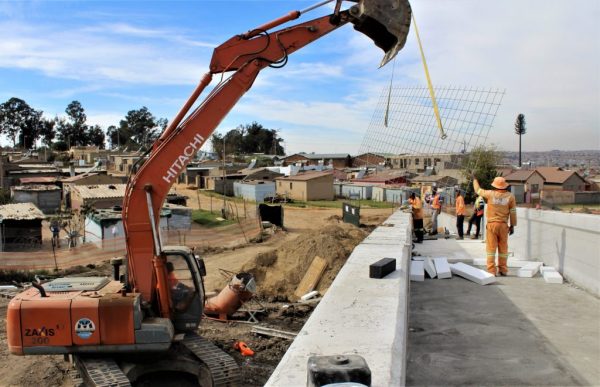CORECIVILS HELPS CITY OF JOHANNESBURG ACCELERATE SERVICE DELIVERY
CoreCivils’ unique precast concrete system has enabled the Johannesburg Roads Agency (JRA) and its professional team to significantly accelerate the construction of a pedestrian bridge in Kaalfontein, Gauteng.
Crossing a stream that traverses the community, the 100-m-long and 3,5-m-wide bridge will help authorities evacuate residents during flood conditions, while also significantly improving mobility by providing a direct connection between Flashlight Fish and Trout Fish Streets.
CoreCivils’ system comprises conventionally reinforced precast beams and hollow-core slabs e supported by two in-situ concrete piers.
The company proposed the use of hollow-core slabs rather than rib-and-block slabs between the precast beams to provide a faster and more accurate means of constructing the superstructure.
These modifications were accepted by the design engineer, BMK Consulting Engineers, which is also overseeing the construction programme on behalf of the JRA.
Jaco de Bruin, MD of CoreCivils, says that the company installed the beams and hollow-core slabs in only a day.
“The hollow-core slabs were manufactured and cut to size at our factory so that they could be placed directly on top of the precast beams. This eliminated the need to first install extensive propping before being able to cast the rib-and-block slabs. Meanwhile, our approach was also better suited to working in an extremely built-up environment and mitigating the need to coordinate construction materials to the site via a very narrow gravel road that services the community,” De Bruin says.
CoreCivils mobilised to site once Axton Matrix’s team had built the two in-situ concrete piers and abutments, as well as the approach ramps and their walls.
The precast elements were dispatched from the company’s factory and lifted directly from the truck trailers using a mobile crane positioned on the north-facing side of the bridge.
Working in very marshy terrain, Axton Matrix had to first construct a secure platform for the crane. It comprised 700-mm-thick G5 material sufficiently compacted to provide the stability needed to lift and place the heavy precast elements. These included the 14 precast beams, two per span and each 15 m long and weighing four tons.
Axton Matrix was able to commence working on the remaining portion of the superstructure immediately after CoreSlab had installed the hollow-core slabs.
The hollow-core slabs are first covered with polystyrene moulds with voids to reduce the load of the 150-mm-thick final concrete slab on the precast beams. Services are then installed on top and covered with a steel mesh to reinforce the final slab.
The in-situ works, including the sides of the structure, are extremely labour intensive and about 17 members of the community had the opportunity to work alongside Axton Matrix’s team on this project.
Meanwhile, an additional 20 people will be employed to work on the extended work scope, which includes constructing 70 m of asphalt roads and sidewalks and installing storm-water drainage, curbing and wing walls.
The project is, another example of the complementary role precast concrete can play in traditional labour-based Expanded Public Works Programme projects.
Notably, there have also been no safety or injury-related incidents on this project, despite working at heights and in close proximity to many dwellings.
Valued at more than R13-million, the project is one of numerous pedestrian bridges that are currently being built by the JRA in the larger Midrand area as part of the City of Johannesburg’s R103,4-million investment into low-income communities.
CoreCivils is also working with Axton Matrix on the construction of another similar pedestrian bridge in Diepsloot, Gauteng.
More information from www.corecivil.co.za






